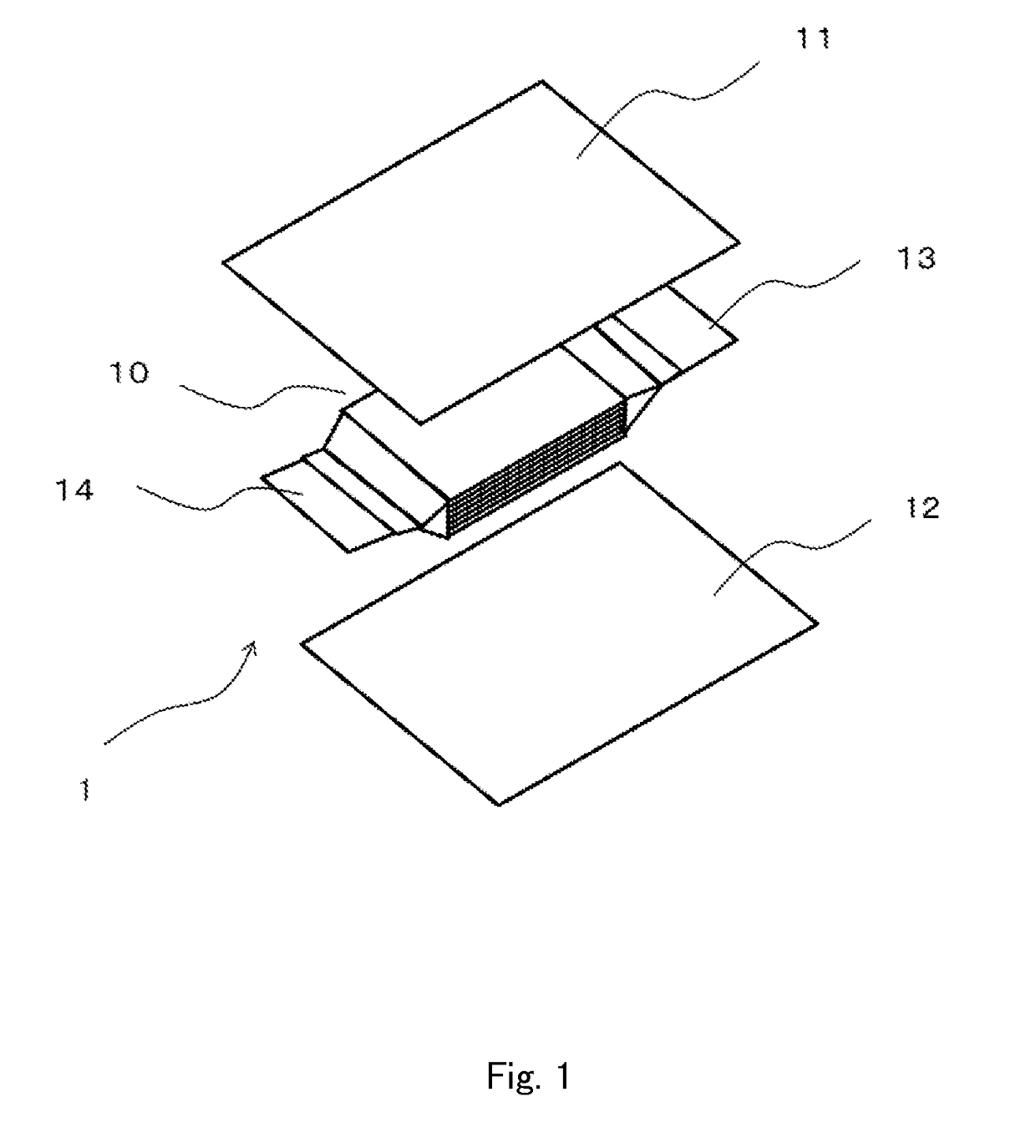Separator, electrode element, electric energy storage device and method for producing separator
a technology of electric energy storage and separator, which is applied in the direction of electrochemical generators, cell components, cell component details, etc., can solve the problems of short circuit between positive and negative electrode plates over wide areas, short circuit between positive and negative electrode plates, etc., and achieve excellent ionic conductivity and yield improvement. , the effect of improving the yield
- Summary
- Abstract
- Description
- Claims
- Application Information
AI Technical Summary
Benefits of technology
Problems solved by technology
Method used
Image
Examples
example 1
Preparation of Battery
[0105](Method for Preparing Positive Electrode)
[0106]A mixture was prepared by mixing 85% by mass of a lithium manganese composite oxide (LiMn2O4) material as a positive electrode active material and 7% by mass of acetylene black as a conductive aid and 8% by mass of polyvinylidene fluoride as a binder; the resulting mixture was dispersed in N-methylpyrrolidone (NMP) to prepare a slurry; then, the slurry was applied to an aluminum foil (15 μm) as a positive electrode current collector and dried. After drying, the electrode was pressed and was prepared for the thickness after press treatment to be 80 μm. The area to which the active material was applied was set to be 100 mm in width and 200 mm in length.
[0107](Method for Preparing Negative Electrode)
[0108]A mixture was prepared by mixing 90% by mass of a graphite material as a negative electrode active material and 10% by mass of polyvinylidene fluoride as a binder; the resulting mixture was dispersed in N-methy...
example 2
[0122]The binder solution for fixing the glass fibers used in Example 1 was altered to a 2% aqueous solution of polyvinyl alcohol (PVA). The aqueous solution of PVA in which glass wool was dispersed was impregnated from one surface of a glass cloth, and the glass cloth impregnated with the aqueous solution of PVA was dried at room temperature and then heat treated at 140° C. for 20 minutes in order to enhance the water resistance and the solvent resistance of PVA. The thickness of the thus prepared separator was 30 μm. Other conditions of preparation of the separator and the conditions of the preparation of the secondary battery were the same as in Example 1, and the prepared secondary battery was evaluated in the same manner as in Example 1.
example 3
[0123]A 10-nm thick polyethylene film was superposed on the same glass cloth as used in Example 1, and heated at 180° C. for 20 minutes. This treatment allowed the glass cloth to be impregnated with the molten polyethylene. Next, on the surface of the glass cloth, cut glass wool was scattered in the same manner as in Example 1. The glass cloth on which cut glass wool was scattered was heated at 180° C. for 10 minutes, and consequently the polyethylene melted again allowed the glass wool to be fixed to the glass cloth. The glass cloth was cooled to room temperature, and then the glass wool not fixed to the glass cloth was removed. The thickness of the thus prepared separator was 28 μm. Accordingly, the thickness of the glass fiber layer was 8 μm. Otherwise under the same conditions as in Example 1, a secondary battery was prepared, and the prepared secondary battery was subjected to the same evaluations as in Example 1.
PUM
| Property | Measurement | Unit |
|---|---|---|
| thickness | aaaaa | aaaaa |
| thickness | aaaaa | aaaaa |
| melting point | aaaaa | aaaaa |
Abstract
Description
Claims
Application Information
 Login to View More
Login to View More - R&D
- Intellectual Property
- Life Sciences
- Materials
- Tech Scout
- Unparalleled Data Quality
- Higher Quality Content
- 60% Fewer Hallucinations
Browse by: Latest US Patents, China's latest patents, Technical Efficacy Thesaurus, Application Domain, Technology Topic, Popular Technical Reports.
© 2025 PatSnap. All rights reserved.Legal|Privacy policy|Modern Slavery Act Transparency Statement|Sitemap|About US| Contact US: help@patsnap.com



